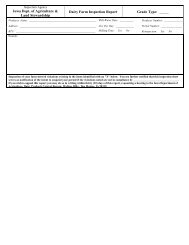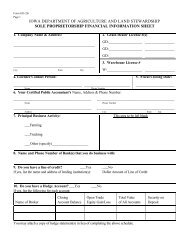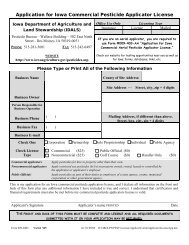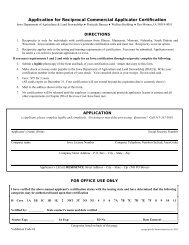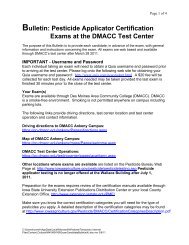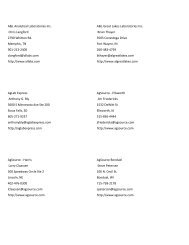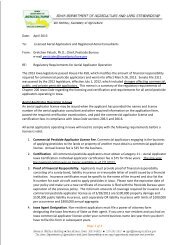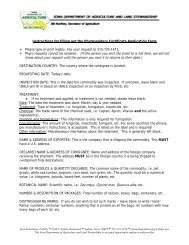Ch 44, p.1 Agriculture and Land Stewardship[21] IAC 4/23/08 - Iowa ...
Ch 44, p.1 Agriculture and Land Stewardship[21] IAC 4/23/08 - Iowa ...
Ch 44, p.1 Agriculture and Land Stewardship[21] IAC 4/23/08 - Iowa ...
Create successful ePaper yourself
Turn your PDF publications into a flip-book with our unique Google optimized e-Paper software.
<strong>Ch</strong> <strong>44</strong>, p.2 <strong>Agriculture</strong> <strong>and</strong> L<strong>and</strong> <strong>Stewardship</strong>[<strong>21</strong>] <strong>IAC</strong> 4/17/91, 4/<strong>23</strong>/<strong>08</strong><strong>21</strong>—<strong>44</strong>.4(206) Certification of construction. Upon completion of construction, certification by theowner or owner’s agent shall be made to the <strong>Iowa</strong> department of agriculture <strong>and</strong> l<strong>and</strong> stewardship thatthe facilities were constructed in accordance with rules <strong>44</strong>.2(206) to <strong>44</strong>.11(206). If departmental investigation,subsequent to the completion of construction, determines the constructed facilities werenot constructed in accordance with the submitted plans <strong>and</strong> specifications or the requirements of theserules, the owner shall correct any deficiencies in a timely manner as set forth by the department.The department may exempt any person from a requirement under rules <strong>21</strong>—<strong>44</strong>.2(206) to<strong>21</strong>—<strong>44</strong>.11(206) if an engineering justification is provided demonstrating variations from the requirementswill result in at least equivalent effectiveness.<strong>21</strong>—<strong>44</strong>.5(206) New pesticide storage <strong>and</strong> mixing site location. New permanent storage <strong>and</strong> mixingsites as defined in rule <strong>44</strong>.1(206) shall be selected in accordance with requirements of the <strong>Iowa</strong> departmentof natural resources. The new site, if located in a flood plain, shall be protected from inundationfrom floods. New permanent pesticide storage <strong>and</strong> mixing sites shall be located a minimum of 400 feetfrom public water supply wells or below ground level finished water storage facilities <strong>and</strong> a minimumof 150 feet from private water supply wells.<strong>21</strong>—<strong>44</strong>.6(206) Pesticide storage <strong>and</strong> mixing site. Each site shall comply with those ordinances <strong>and</strong>regulations enacted by the city or county affected by such location that related to the location of suchsites. All sites <strong>and</strong> facilities where flammable pesticides are stored shall comply with state <strong>and</strong> federalfire protection rules <strong>and</strong> regulations, including the National Fire Protection St<strong>and</strong>ards (St<strong>and</strong>ard 30)for storage of flammable liquids.<strong>21</strong>—<strong>44</strong>.7(206) Secondary containment for nonmobile bulk pesticide storage <strong>and</strong> mixing. Base<strong>and</strong> walls of secondary containment facilities must be constructed of concrete, steel or other imperviousmaterials which are compatible with the pesticides being stored <strong>and</strong> will maintain their integrityunder fire conditions. Storage containers must be anchored, as necessary, to prevent flotation or instabilityin the event of discharge into the secondary containment facility. Routine inspection is requiredto ensure against cracks or other conditions that may reduce the effectiveness of the containment facility.Cracks that occur in a secondary containment structure must be repaired with an acceptable sealant,<strong>and</strong> other repairs shall be made as needed to maintain the effectiveness of the containment facility.The diked area shall not have a relief outlet <strong>and</strong> valve. The base shall slope to a collecting spotwhere precipitation water may be pumped out, provided the liquid is not contaminated with pesticides.If contaminated with a pesticide, the liquid shall be disposed of in accordance with applicable hazardousor solid waste requirements or field applied according to the pesticide label instructions.<strong>44</strong>.7(1) Storage in other than an enclosed structure.a. Secondary containment for nonmobile bulk liquid pesticide storage located in other than anenclosed structure shall be constructed with a volume sufficient to contain a minimum of 110 percentof the capacity of the largest single container, plus the space occupied by other tanks located within thesecondary containment structure.b. Secondary containment for nonmobile bulk dry pesticide storage located in other than an enclosedstructure shall be constructed to contain any releases of dry pesticide. The secondary containmentwill have as a minimum a six-inch high curb separated horizontally from the storage vessel aminimum of three feet. Provisions shall be made for the collection of rainwater, <strong>and</strong> rainwater shall notbe allowed to accumulate in the containment structure.<strong>IAC</strong> 4/17/91, 4/<strong>23</strong>/<strong>08</strong>
<strong>IAC</strong> 4/<strong>23</strong>/<strong>08</strong><strong>Agriculture</strong> <strong>and</strong> L<strong>and</strong> <strong>Stewardship</strong>[<strong>21</strong>]<strong>Ch</strong> <strong>44</strong>, p.5<strong>21</strong>—<strong>44</strong>.11(206) Distribution of bulk pesticides. Bulk repackaging for sale or delivery may be madeprovided the establishment conducting the transfer, sale or delivery shall comply with FIFRA, Section7 (registration of pesticide producing establishments).<strong>44</strong>.11(1) There shall be no change in pesticide product labeling, except for the addition of the requiredEPA establishment number <strong>and</strong> net contents statement; or identity of the party accountable forthe integrity of the product, i.e., the manufacturer or registrant as evidenced by the assigned EPA productregistration number.<strong>44</strong>.11(2) A written letter of authorization from the registrant is required for the bulk repackaging.<strong>44</strong>.11(3) Bulk repackaging may be made only into containers which conform with rules<strong>21</strong>—<strong>44</strong>.8(206) <strong>and</strong> <strong>44</strong>.9(206) <strong>and</strong> which meet the approval of the seller of the pesticide.<strong>44</strong>.11(4) Scales or meters used for bulk pesticide sales shall meet the specifications, tolerances <strong>and</strong>other technical requirements for weighing <strong>and</strong> measuring devices as specified by the <strong>Iowa</strong> departmentof agriculture <strong>and</strong> l<strong>and</strong> stewardship, bureau of weights <strong>and</strong> measures.<strong>44</strong>.11(5) Appropriate measures shall be taken to prevent contamination of product when meters orother devices are used to dispense pesticides.These rules are intended to implement <strong>Iowa</strong> Code section 206.19.<strong>21</strong>—<strong>44</strong>.12(206) Secondary containment for aerial applicator aircraft. If the spray component ofan aircraft is being drained or repaired during aircraft maintenance, secondary containment with permanentdevices or portable devices suitable for use with pesticides is required.<strong>21</strong>—<strong>44</strong>.13 to <strong>44</strong>.49 Reserved.FERTILIZERS AND SOIL CONDITIONERS<strong>21</strong>—<strong>44</strong>.50(200) On-site containment of fertilizers <strong>and</strong> soil conditioners. Effective February 18,1987, all new construction of fertilizer <strong>and</strong> soil conditioner facilities shall provide secondary productcontainment as specified in rules <strong>21</strong>—<strong>44</strong>.51(200) to <strong>21</strong>—<strong>44</strong>.58(200). Effective February 18, 1997,ten years after the adoption of these rules, all fertilizer <strong>and</strong> soil conditioner facilities shall provide secondaryproduct containment as specified in these rules.<strong>21</strong>—<strong>44</strong>.51(200) Definitions.“Mobile containers.” Containers designed <strong>and</strong> used for transporting fertilizer or soil conditionermaterials.“Nonmobile containers.” All containers not defined as mobile.“Permanent storage site.” Location where nonmobile containers are used for fertilizer <strong>and</strong> soilconditioner storage in quantities of 5,000 gallons or more. One container or a combination of containerswith a volume of 5,000 gallons or less is exempt.“Secondary containment.” Any structure used to prevent runoff or leaching of fertilizer or soil conditionermaterials.<strong>21</strong>—<strong>44</strong>.52(200) Design plans <strong>and</strong> specifications. Design plans <strong>and</strong> specifications for facilities requiredunder these rules shall be submitted to the <strong>Iowa</strong> department of agriculture <strong>and</strong> l<strong>and</strong> stewardshipprior to the start of construction, along with certification from a registered engineer (as defined in <strong>Iowa</strong>Code chapter 542B) that the designed facilities will comply with all requirements of these rules.A person may deviate from the requirements of these rules if such deviations are clearly noted on thedesign plans <strong>and</strong> specifications, along with certification from a registered engineer that these deviationswill not reduce the effectiveness of the facilities in protecting surface or groundwaters.<strong>IAC</strong> 4/<strong>23</strong>/<strong>08</strong>
<strong>Ch</strong> <strong>44</strong>, p.6 <strong>Agriculture</strong> <strong>and</strong> L<strong>and</strong> <strong>Stewardship</strong>[<strong>21</strong>] <strong>IAC</strong> 7/27/88, 4/<strong>23</strong>/<strong>08</strong><strong>21</strong>—<strong>44</strong>.53(200) New fertilizer or soil conditioner storage site location. New permanent storagesites as defined in rule <strong>21</strong>—<strong>44</strong>.51(200) shall be selected in accordance with the requirements of the<strong>Iowa</strong> department of natural resources. The new site, if located in a floodplain, shall be protected frominundation from floods. New permanent fertilizer <strong>and</strong> soil conditioner storage sites shall be located at aminimum of 400 feet from public water supply wells or below ground level finished water storage facilities<strong>and</strong> a minimum of 150 feet from private water supply wells.<strong>21</strong>—<strong>44</strong>.54(200) Certification of construction. Upon completion of construction, certification by theowner or owner’s agent shall be made to the <strong>Iowa</strong> department of agriculture <strong>and</strong> l<strong>and</strong> stewardship thatthe facilities were constructed in accordance with rules <strong>21</strong>—<strong>44</strong>.52(200) to <strong>21</strong>—<strong>44</strong>.58(200). If departmentalinvestigation, subsequent to the completion of construction, determines the constructed facilitieswere not constructed in accordance with the submitted plans <strong>and</strong> specifications or the requirementsof these rules, the owner shall correct any deficiencies in a timely manner as set forth by the department.The department may exempt any person from a requirement under rules <strong>21</strong>—<strong>44</strong>.52(200) to<strong>21</strong>—<strong>44</strong>.58(200) if an engineering justification is provided demonstrating variations from the requirementswill result in at least equivalent effectiveness.<strong>21</strong>—<strong>44</strong>.55(200) Secondary containment for liquid fertilizers <strong>and</strong> liquid soil conditioner storage.All liquid fertilizer <strong>and</strong> soil conditioner storage facilities, except anhydrous ammonia storage facilities,as defined in rule <strong>21</strong>—<strong>44</strong>.51(200) shall be located within a secondary containment structure. Thesecondary containment structure shall have a volume 20 percent greater than the volume of the largeststorage tank within the area, plus the space occupied by the other tanks in the area, <strong>and</strong> may beconstructed of earth, concrete, or a combination of both.<strong>44</strong>.55(1) Secondary containment structures constructed entirely or partially of earth shall complywith the following minimum requirements:a. The soil surface, including dike, shall be constructed to prevent downward water movement atrates greater than 1 x 10 -6 cm/sec., <strong>and</strong> shall be maintained to prevent downward water movement atrates greater than 1 x 10 -5 cm/sec. The method of achieving a satisfactory seal shall be determined by aregistered engineer.b. Dike shall be protected against erosion. If the slope is 30 degrees or less, grass can be sufficientprotection, provided it does not interfere with the required soil seal. If greater than 30 degrees, othermethods of erosion protection shall be used.c. Top width of dike shall be no less than 2½ feet. The slope should be no greater than 45 degrees.d. The diked area shall not have a relief outlet <strong>and</strong> valve. The base shall slope to a collecting spotwhere storm water can be pumped over the berm, provided the liquid is not contaminated with fertilizeror soil conditioner materials. If contaminated with liquid fertilizer or soil conditioner, the liquid shallbe field applied at normal fertilizer application rates or transferred to auxiliary storage tanks.e. Storage containers shall be anchored or placed on a raised area to prevent flotation or instabilityin the event of discharge into the secondary containment facility.<strong>44</strong>.55(2) Secondary containment structures constructed of concrete shall be watertight <strong>and</strong> complywith the following requirements:a. The base of the containment structure shall be designed to support all tanks <strong>and</strong> their contents.b. The diked area shall not have a relief outlet <strong>and</strong> valve. The concrete base shall be sloped to acollecting area for recovery of fertilizer material. Storm water may be discharged over the containmentwall, provided the liquid is not contaminated with fertilizer or soil conditioner material. If contaminated,the liquid shall be field applied at normal fertilizer application rates or transferred to auxiliarystorage tanks.<strong>IAC</strong> 7/27/88, 4/<strong>23</strong>/<strong>08</strong>
<strong>IAC</strong> 7/27/88, 4/<strong>23</strong>/<strong>08</strong><strong>Agriculture</strong> <strong>and</strong> L<strong>and</strong> <strong>Stewardship</strong>[<strong>21</strong>]<strong>Ch</strong> <strong>44</strong>, p.7c. Storage containers shall be anchored or placed on a raised area to prevent flotation or instabilityin the event of discharge into the secondary containment facility.d. Routine inspection is required to ensure against concrete cracks. Where cracks exist, storageintegrity shall be maintained with acceptable sealant.<strong>21</strong>—<strong>44</strong>.56(200) Secondary containment for nonliquid fertilizers <strong>and</strong> soil conditioners. Nonliquidfertilizer <strong>and</strong> soil conditioner stored in a totally enclosed building are exempt from the requirementsof this rule. Unless stored in a totally enclosed building, all nonliquid fertilizer <strong>and</strong> soil conditionermaterials shall be stored within an area which drains into a secondary containment structure.The secondary containment structure shall have a volume sufficient to retain the equivalent of 12 inchesof runoff from the area drained into the containment structure. This minimum storage volume maybe provided within the containment structure or in auxiliary storage tanks, <strong>and</strong> may be constructed ofearth, concrete, or a combination of both.<strong>44</strong>.56(1) Secondary containment structures constructed entirely or partially of earth shall complywith the following requirements:a. The soil surface, including dike, shall be constructed to prevent downward water movement atrates greater than 1 x 10 -6 cm/sec., <strong>and</strong> shall be maintained to prevent downward water movement atrates greater than 1 x 10 -5 cm/sec. The method of achieving a satisfactory seal shall be determined by aregistered engineer.b. Dike shall be protected against erosion. If the slope is 30 degrees or less, grass can be sufficientprotection, provided it does not interfere with the required soil seal. If greater than 30 degrees, othermethods of erosion protection shall be used.c. Top width of dike shall be no less than 2½ feet. The slope should be no greater than 45 degrees.d. The diked area shall not have a relief outlet.e. All liquid <strong>and</strong> other material collected shall be field applied at normal fertilizer applicationrates or transferred to auxiliary storage tanks.<strong>44</strong>.56(2) Runoff collection structures constructed of concrete shall comply with the following requirements:a. The base of the structure shall be maintained to prevent downward water movement.b. The diked area shall not have a relief outlet.c. All liquid <strong>and</strong> other material collected shall be field applied at normal fertilizer applicationrates or transferred to auxiliary storage tanks.These rules are intended to implement <strong>Iowa</strong> Code section 200.14.<strong>21</strong>—<strong>44</strong>.57(200) Fertilizer loading, unloading, <strong>and</strong> mixing area.<strong>44</strong>.57(1) All loading, unloading, <strong>and</strong> mixing of liquid fertilizer or liquid soil conditioners, unlessperformed in the field of application, shall be done within a containment area. The containment areashall be large enough to prevent spillage onto unprotected areas <strong>and</strong> paved with asphalt, concrete, orother impervious material. It shall slope to a recovery system that will allow collected materials tomove to a containment structure which complies with rule <strong>21</strong>—<strong>44</strong>.55(200). In addition, the area shallbe so constructed, using curbs or other means, as to prevent spilled materials from running out of thecontainment area. Any contaminated liquid or material shall be field applied at normal fertilizer ratesor used in a liquid mixing operation.<strong>44</strong>.57(2) All loading or mixing of nonliquid fertilizers or nonliquid soil conditioners at permanentstorage sites shall be done in an area paved with asphalt, concrete or other impervious materials. Thearea shall also be so constructed, using curbs or other means to prevent runon or runoff of storm watergenerated by a four-inch rain. The area shall contain a recessed catch basin so that contaminated watercan be moved to storage tanks or a secondary containment area. Uncontaminated rain water, ice, orsnow can be discharged as storm water. Any contaminated water or other materials shall be field appliedat normal fertilizer rates or used in a liquid mixing operation.<strong>IAC</strong> 7/27/88, 4/<strong>23</strong>/<strong>08</strong>
<strong>Ch</strong> <strong>44</strong>, p.8 <strong>Agriculture</strong> <strong>and</strong> L<strong>and</strong> <strong>Stewardship</strong>[<strong>21</strong>] <strong>IAC</strong> 4/<strong>23</strong>/<strong>08</strong><strong>44</strong>.57(3) A spill containment structure will not be required if loading, unloading, or mixing of anonliquid fertilizer or nonliquid soil conditioners is done entirely within an enclosed building <strong>and</strong> nowashing operations are conducted within the enclosed area.<strong>44</strong>.57(4) Unloading of all types of equipment <strong>and</strong> loading of railroad cars with nonliquid fertilizeror nonliquid soil conditioners shall be exempt from the containment area provisions of subrule<strong>44</strong>.57(2) provided any materials spilled during the unloading/loading operations are promptly cleanedup <strong>and</strong> fed back into the unloading/loading system.<strong>44</strong>.57(5) Rules <strong>21</strong>—<strong>44</strong>.2(206) to <strong>21</strong>—<strong>44</strong>.11(206) shall apply when fertilizers or soil conditioners<strong>and</strong> pesticides are combined.<strong>44</strong>.57(6) Fertilizers <strong>and</strong> soil conditioners must be h<strong>and</strong>led in a manner that minimizes dust <strong>and</strong> vaporsfrom movement off of the site.<strong>21</strong>—<strong>44</strong>.58(200) Wash water <strong>and</strong> rinsates. All washing of fertilizer <strong>and</strong> soil conditioner h<strong>and</strong>ling<strong>and</strong> application equipment at permanent storage sites shall be conducted within an area which drainsinto a containment structure which complies with rule <strong>21</strong>—<strong>44</strong>.55(200). No fertilizer rinsates or washwaters from fertilizer or soil conditioner equipment shall be disposed of through sanitary or storm sewersystems. Field washing of fertilizer or soil conditioner equipment is permissible <strong>and</strong> encouraged ifperformed at the site of final fertilizer or soil conditioner application for a given day <strong>and</strong> no runoff fromthe wash site occurs.These rules are intended to implement <strong>Iowa</strong> Code section 200.14.[Filed 9/19/86, Notice 7/2/86—published 10/8/86, effective 11/12/86]*[Filed 12/29/86, Notice 11/19/86—published 1/14/87, effective 2/18/87][Filed emergency 2/18/87—published 3/11/87, effective 2/18/87][Filed emergency 7/8/88 after Notice 6/1/88—published 7/27/88, effective 7/8/88][Filed emergency 3/<strong>21</strong>/91—published 4/17/91, effective 3/<strong>21</strong>/91][Filed emergency 4/4/<strong>08</strong> after Notice 2/27/<strong>08</strong>—published 4/<strong>23</strong>/<strong>08</strong>, effective 4/4/<strong>08</strong>]*Effective date of 9.3 <strong>and</strong> 9.7 delayed seventy days by the Administrative Rules Review Committee at its 11/11/86 meeting.(<strong>Ch</strong>apter 9 renumbered as <strong>Ch</strong>apter <strong>44</strong>, <strong>IAC</strong> 7/27/88)<strong>IAC</strong> 4/<strong>23</strong>/<strong>08</strong>


![Ch 44, p.1 Agriculture and Land Stewardship[21] IAC 4/23/08 - Iowa ...](https://img.yumpu.com/49992480/1/500x640/ch-44-p1-agriculture-and-land-stewardship21-iac-4-23-08-iowa-.jpg)

